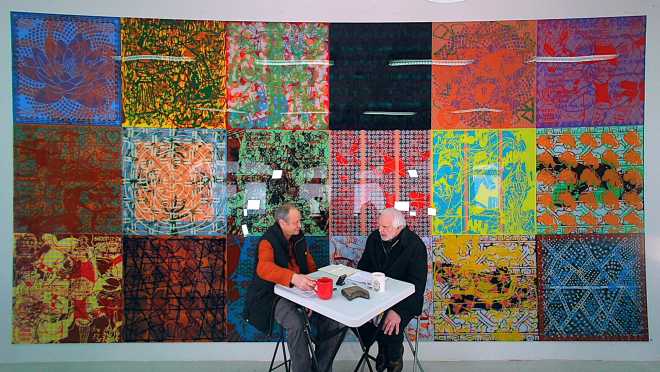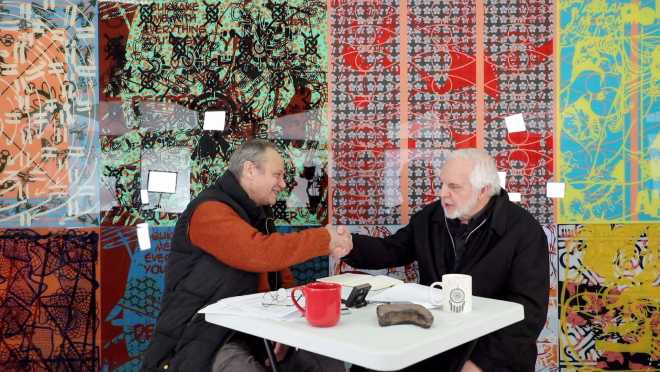34 INTERVIEWS | (x 106) VIDEOS
INTERVIEW WITH JOHNES RUTA, ART HISTORIAN & CRITIC [in English, with English subtitles]
Interview with my lifelong friend, Johnes Ruta, who came from the USA to visit me and other artist friends in Prague, Vienna and Paris during his trip to Europe in the spring of 2024.
We filmed these interview series on Sunday April 21 2024, and it was very cold in the studio. Johnes, as always, had a lots of interesting questions to ask me....
About Johnes Ruta : "As an arts activist, I consider it my personal mission to develop public understanding of individual creativity, especially toward the appreciation of arts, culture, and the positive evolution of humanity."
- He is an art theorist from New Haven, Connecticut, USA and have worked with
artists from all over the world, as the editor of an arts newspaper in the 1970s, and as
an independent curator since 1988 at the Azoth Gallery in New Haven, creating group and solo exhibits in many venues
and professional galleries in CT and New York City. His career was consulting in data
systems development in aerospace and chemical engineering applications. His surrealist novel Fires Eternal Morning, composed of dreams, was published in 2015
by Poets Choice Press. Since 2001, in CT, he have sponsored occasional three-day
historical symposia with presentations from mathematicians, architects, mythologists,
and scientists from all over the USA.
- READ THE TRANSCRIPTS
JOHNES RUTA: Good morning and good afternoon, it's today April 21st 2024, I'm Johnes Ruta from New Haven, Connecticut, USA. I'm an independent curator, an art theorist and a writer, and I'm here with my long-time dear friend Jean-Pierre Sergent, who I knew from when he lived in Long Island City, in New York, were he stayed until 2003. And I've come here to talk with him and to spend some time and see his work and to learn about what he's working on these days and renew our friendship. So, I would like to ask him some questions about his work and have him, speak, informally as much as possible. So, I have some questions I wanted to ask him about his time in New York, about the years that he spent there. He said from 1993 to 2003. And, how you got there, Jean-Pierre? And about your associations there, with artists and your affinity with the beat generation, with Alexandra David-Néel…
JEAN-PIERRE SERGENT : Oh yes, but she's not part of the beat generation!
JPS: Part two, Johnes, so you wanted to talk about something else?
JR: We'll go around the bar, let's address your methodology a little bit, at this time, and then we'll relate that to a more philosophical level in your work.
JPS: Okay.
JR: And you can make those associations as you like. In the sense of your print making works that are made by a superimposition of motifs, imageries and figures, sometimes underlying layers and the technique as we discussed, understood as 'reverse glass' painting! In painting, I've seen this many times, but in printing it's much more complicated! Reverse glass process in which foregrounds (the first layers) are painted first silkscreened inside of a 1.05 x 1.05 m square transparent plexiglass. Actually, you're working on an inside-out sequence in accumulating successive layers; and your imagery is often interlocking stars patterns, such as in Arabic non figurative art (as moucharabieh: hidden-unveiled). Whereas in your work there's more association with figures, in imagery often erotic. And these are really, I would say, comprehensively manifested in your work. In the sense of comprehensively, that they're integral and integrated in your working process?
JPS: Yeah, in fact, I'm using silkscreen printing. So I'm printing the images on this table, that belonged to Andy Warhol, it was at his Factory.
JR: So, let's talk for a moment about the technical issues. Can you elaborate on your working process? And also talk about some of the technical problems that you have in creating a piece, using silkscreen and printing on Plexiglas using this reverse glass work process?
JPS: Well, it is complicated, but I'm getting to a point where I know exactly what I'm doing. Everything is set up for my prints. I am used to it, you know. Of course, it's complicated to print on such a smooth surface like plexiglass, it's really complicated. Yes, especially for the registration of the image, because my paintings panels are divided in two parts. So I have to be well registering and setting perfectly the films and the silk-screens frames, so the image are well and straight printed. But, it's okay.
JR: Yes.
JPS: Anyhow, today, as often, my main problem is to find money to work, because I need to buy some paint and inks and paper. Heidi Suter, my gallerist from Zurich just bought me a Plexiglas painting, so I could buy some new materials for working again and I am really happy about that!
JR: And you're working with inks or paints?
JPS: Mostly with acrylic, regular acrylic paint.
JR: Ah, I see, okay. So your work involves, a process of accumulated layering and adding several layers on top of each others?
JR: So Jean-Pierre, thinking as a theoretical observer, I can see and feel the subtleties that emerge from the inner layers of patterns, often over a period of time, which is interesting in terms of collecting art, because what happens, in many ways and many of my own collection, I see different things over a period of time looking at the same art.
JPS: Okay, yes...
JR: So that's very good, because then they have subtlety. So after first viewing, you know, things change and also the sensitivities and the affinities of objects and figures; and each figure, which is depicted, how should I say, ae subsumed in their personal context? Showing presences which relate to issues of eroticism and relations between individuals, so what do you think of that?
JPS: I will tell you an anecdote, that's from the place and time when we met at the Alliance Française in New York, in 1996 and I had 4 paintings exhibited side by side (140 x 560 cm) for the exhibition Suspended Time, in the hallway and the receptionist at the desk, was sitting right in front of my painting, for maybe like two weeks (before seeing what was into the painting).
JR: Okay, just going back at one point, we had referred about the Egyptian Goddess Isis and what you had described, that mythical presences that explore unfathomable depths of intimacy. I thought that was a very interesting perception. And I want to try to, I'm not asking for a contrast, but, how, the theories and philosophies of John Cage, with his idea of silence, also has to do with the Void itself. What is inside of the Void, of Silence. And what he did was to elaborate, first of all, was a kind of approach to an absolute silence, if there is such a thing? Secondly, that there is an organic harmonic that takes place in human life that there is no actual silence. I don't want to get into this story, but one curious thing he said very briefly was, that he went to the Anechoic chamber at MIT (the Massachusetts Institute of Technology). Going into it, the technician said: "this is a place where there's absolutely no sound!"
JR: Did you want to talk about Tarkovsky?
JPS: I do have a sentence to quote from him, sure. So yes, Johnes:
JR: There were also a reference in your Notes 2023 to Tarkovsky's book called "Sealed Time", which I'm not familiar with. And I'm very curious because this film work is very interesting. Was that more about his film work?
JPS: It's about what he's thinking when he is shooting some movies (about Art, literature, time, movies, actors..). I really love his movies. Even it's a long time since I have seen some of his movies, but he is really interesting as a creator... He is talking about books, about Nature, about Life... I mean, I have a few quotations from him here.
JR: I think of his work in terms of being situational. How people interact even in environments in the spaceship where one of the crew people thinks he sees his wife who passed away on the ship with him.
JPS: Which movie are you talking about? Anyhow, what is most important in Tarkovsky films, is that it's always filmed in nature most of the time. Nature with Fire, Water, Trees all the primary elements are there! It is a bit like the Terrence Malick did the New World, a really famous and very spiritual movie maker. So, Tarkovsky says:
"When I speak of the aspiration to beauty, (we were just talking about that) of the ideal as the ultimate goal of Art, which stems from an ardent desire for this ideal. I'm not suggesting for a moment that Art should flee the "dirt" of the world. On the contrary!"







